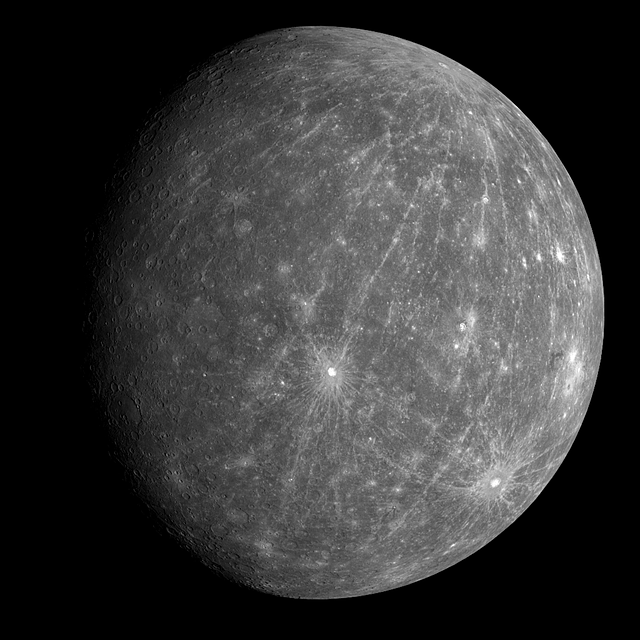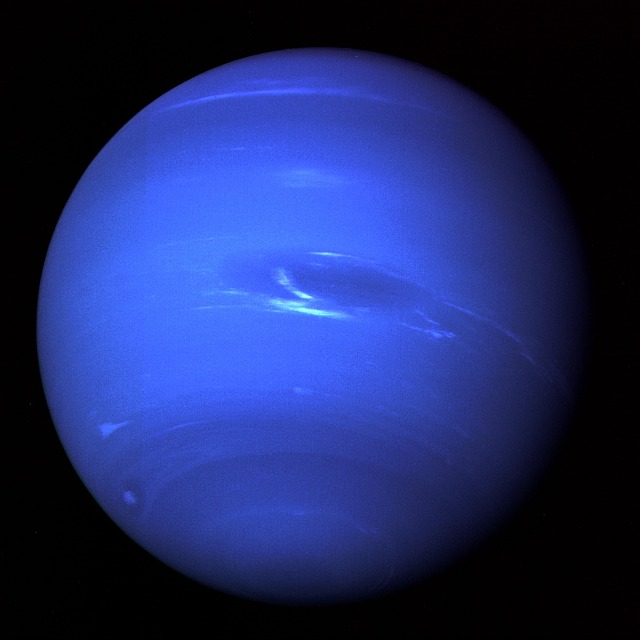*This post may contain affiliate links. This means we may make a commission if you purchase an item using one of our links*
The main differences between Mercury and Neptune are that Mercury is the closest planet to the Sun whilst Neptune is the 8th farthest, Neptune is a deep blue ice based gas giant whilst Mercury is a dark gray terrestrial planet, Mercury has no moon whilst Neptune has 14 and Mercury is far hotter at 167°C as opposed to Neptune’s temperatures of around -220 to -230°C.
There are numerous other differences between Mercury and Neptune so, continue reading for a more thorough breakdown of what they are below.
What Is The Planet Mercury?
Table of Contents

Mercury is the planet closest to our Sun and would fall under the terrestrial planet moniker. Out of the 8 main line planets Mercury is also the smallest, coming in at 4,879km.
This planet is known for having its fair share of craters, which is mostly down to its thinner non protective atmosphere that is unable to stop interstellar debris from striking its surface.
Despite its close proximity to the Sun, Mercury is not the hottest planet in our solar system but, it does come in second, just behind Venus. It’s surface temperature is around 430 degrees on the upper end with the average temperature around 167 degrees Celsius whereas its core is far hotter at around 1,600 – 3,000 degrees Celsius.
Due to it close proximity to our local star, Mercury is unable to sustain a moon around its orbit and even has a very unique rotation around the Sun where it has 3:2 orbital resonance with the Sun.
As for how long it takes for the planet to rotate around our yellow dwarf star, its the shortest time period of 88 days for obvious reasons, whilst a single day on the planet takes 58.65 Earth days to complete. Its axial tilt is only 2 degrees to the right, making it amongst the straightest planets in the solar system too.
What Is The Planet Neptune?

Neptune is the 8th farthest planet from the Sun and ranks among the bigger planets in our solar system. As the 8th farthest planet from the Sun, it does take Neptune a very long time to complete 1 orbital around the Sun.
This takes 165 years to complete which in comparison to the 16 hour 1 full spin around the axis is a massive difference.
In regards to its composition, Neptune is mostly made up of a thick swath of water closer to the center, methane, ammonia, hydrogen and helium molded around its Earth sized core.
As a result of the excess amount of methane and the inclusion of another undiscovered element within the atmosphere, Neptune’s color is a far deeper blue than the likes Uranus, which also has an abundantly methane based atmosphere.
The planet is 49,244km in diameter, making it roughly 4 times Earth’s diameter Earth, and would allow around 57 Earths to fit inside it. This also makes Neptune the 4th largest planet in our solar system.
Neptune is very cold mostly down to its distance from the Sun, where its atmospheric temperature sits between-220 to -230 degrees Celsius. Its core is far hotter coming in at 5,100 degrees Celsius and is the very likely cause for the liquid water present within the planet
Subsequently, the erratic temperature and gaseous composition of Neptune, is what constitute towards its turbulent behavior.
In fact Neptune has the fasted winds in our solar system, producing some that eclipse speeds of 2,000km per hour. The fastest winds on Earth would only be a fifth of these speeds at most.
At this moment in time we have discovered 14 moons orbiting Neptune and have also observed 5 thinner rings surrounding the ice giant.
Similarities Between Mercury And Neptune
Mercury and Neptune don’t have very much in common but there are the odd few similarities between them. These common features include the following:
- Both have a hotter central core.
- Both are a spherical in shape.
- Both orbit the Sun in a circular pattern.
- Neither are tidally locked to the Sun.
Differences Between Mercury And Neptune
As for the differences between the two, they include the following:
- Neptune has 14 moons whilst Mercury has 0.
- Neptune has 5 rings whilst Neptune has 0.
- Mercury is a terrestrial planet whilst Neptune is an ice based gas giant aka an ice giant.
- Neptune is a deep blue color whilst Mercury is dark gray.
- Mercury is much hotter with an average temperature of 167°C as opposed to the -220 to -230°C Neptune appears to display.
- Mercury is the denser of the two planets considering it’s composition but, Neptune is still the densest gas based planet in our solar system.
- Neptune is far bigger with a diameter of 49,244km as opposed to Mercury’s diameter of 4,879km.
- Neptune has the fastest winds in our solar system which would be around 2,000 km/h as opposed Mercury which has an extremely thin atmospheres which doesn’t allow for erratic weather on its surface.
- As a result of the lack of atmosphere, Mercury does have a lot of craters on its surface.
- Neptune’s gravity is stronger than Mercury’s where its effects are 11.15 m/s² whereas Mercury’s is 3.7 m/s²
- It takes Neptune 16 hours to complete a spin around its axis whilst Mercury does so in 58.65 days.
- Mercury has a 2 degree axial tilt whilst Neptune’s tilt is 28 degrees.
- It takes Neptune 165 years to orbit the Sun whilst Mercury does so in 88 days.
- Mercury is in a 3:2 orbital resonance with the Sun whilst Neptune is not.
- Neptune is heavier than Mercury with a mass of 1.024 × 10^26 kg and opposed to Mercury’s that is 3.285 × 10^23 kg
Summary
Although Mercury and Neptune are both part of the same solar system and orbit the same Sun, they still differ more than they are similar.
From one being a terrestrial planet and the other an ice giant, one having little to no atmosphere and the other an atmosphere so thick that the winds it produces are the strongest in our solar system, and of course their differences in proximity to the Sun does result in one having more moons and the other not.
All in all in Neptune and Mercury are very different from one another therefore, therefore characteristics and function are very much distinct from one another.

